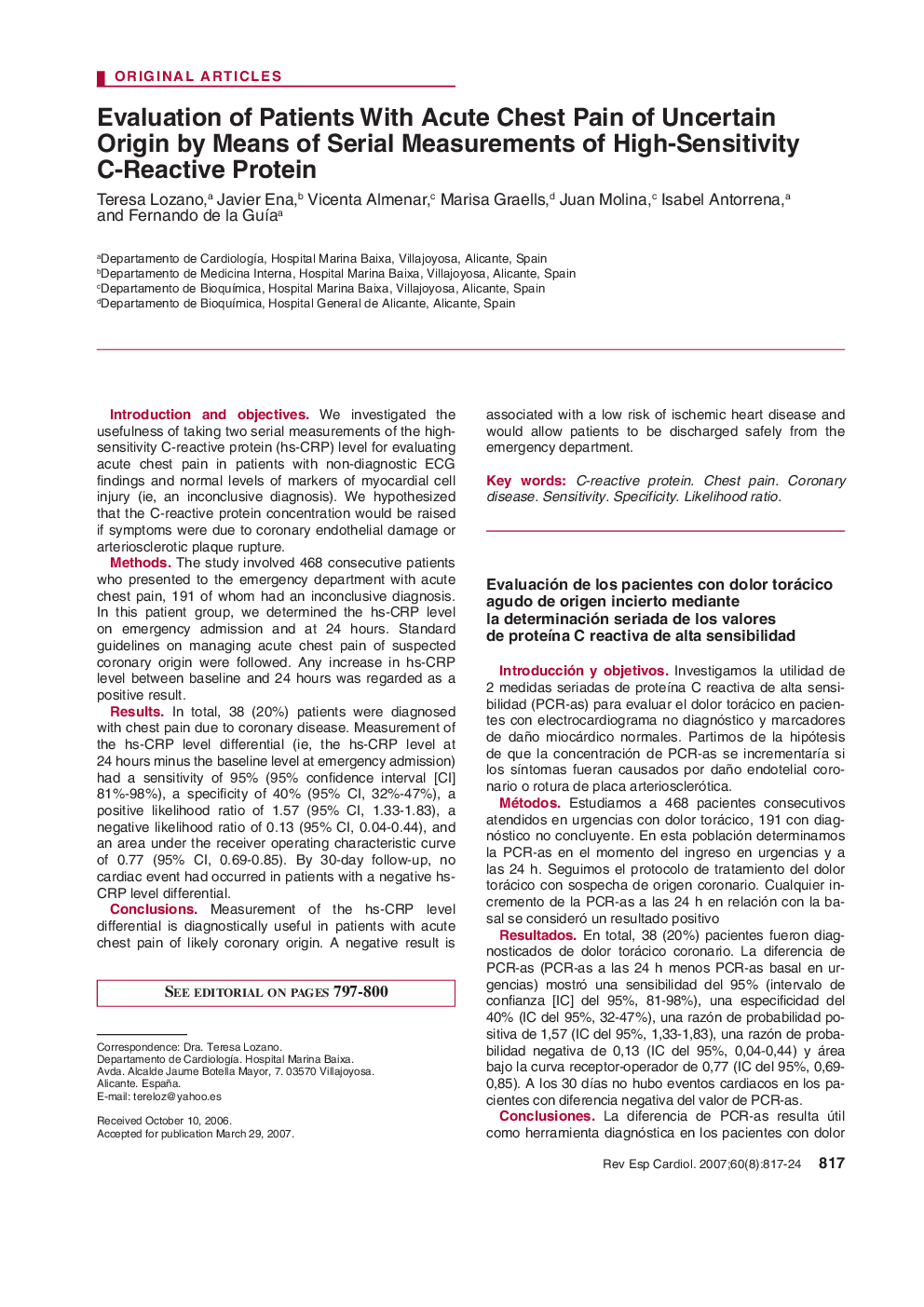| کد مقاله | کد نشریه | سال انتشار | مقاله انگلیسی | نسخه تمام متن |
|---|---|---|---|---|
| 3017492 | 1182121 | 2007 | 8 صفحه PDF | دانلود رایگان |

Introduction and objectivesWe investigated the usefulness of taking two serial measurements of the highsensitivity C-reactive protein (hs-CRP) level for evaluating acute chest pain in patients with non-diagnostic ECG findings and normal levels of markers of myocardial cell injury (ie, an inconclusive diagnosis). We hypothesized that the C-reactive protein concentration would be raised if symptoms were due to coronary endothelial damage or arteriosclerotic plaque rupture.MethodsThe study involved 468 consecutive patients who presented to the emergency department with acute chest pain, 191 of whom had an inconclusive diagnosis. In this patient group, we determined the hs-CRP level on emergency admission and at 24 hours. Standard guidelines on managing acute chest pain of suspected coronary origin were followed. Any increase in hs-CRP level between baseline and 24 hours was regarded as a positive result.ResultsIn total, 38 (20%) patients were diagnosed with chest pain due to coronary disease. Measurement of the hs-CRP level differential (ie, the hs-CRP level at 24 hours minus the baseline level at emergency admission) had a sensitivity of 95% (95% confidence interval [CI] 81%-98%), a specificity of 40% (95% CI, 32%-47%), a positive likelihood ratio of 1.57 (95% CI, 1.33–1.83), a negative likelihood ratio of 0.13 (95% CI, 0.04–0.44), and an area under the receiver operating characteristic curve of 0.77 (95% CI, 0.69–0.85). By 30-day follow-up, no cardiac event had occurred in patients with a negative hs-CRP level differential.ConclusionsMeasurement of the hs-CRP level differential is diagnostically useful in patients with acute chest pain of likely coronary origin. A negative result is associated with a low risk of ischemic heart disease and would allow patients to be discharged safely from the emergency department.
Introducción y objetivosInvestigamos la utilidad de 2 medidas seriadas de proteína C reactiva de alta sensibilidad (PCR-as) para evaluar el dolor torácico en pacientes con electrocardiograma no diagnóstico y marcadores de daño miocárdico normales. Partimos de la hipótesis de que la concentración de PCR-as se incrementaría si los síntomas fueran causados por daño endotelial coronario o rotura de placa arteriosclerótica.MétodosEstudiamos a 468 pacientes consecutivos atendidos en urgencias con dolor torácico, 191 con diagnóstico no concluyente. En esta población determinamos la PCR-as en el momento del ingreso en urgencias y a las 24 h. Seguimos el protocolo de tratamiento del dolor torácico con sospecha de origen coronario. Cualquier incremento de la PCR-as a las 24 h en relación con la basal se consideró un resultado positivoResultadosEn total, 38 (20%) pacientes fueron diagnosticados de dolor torácico coronario. La diferencia de PCR-as (PCR-as a las 24 h menos PCR-as basal en urgencias) mostró una sensibilidad del 95% (intervalo de confianza [IC] del 95%, 81–98%), una especificidad del 40% (IC del 95%, 32–47%), una razón de probabilidad positiva de 1,57 (IC del 95%, 1,33–1,83), una razón de probabilidad negativa de 0,13 (IC del 95%, 0,04–0,44) y área bajo la curva receptor-operador de 0,77 (IC del 95%, 0,69–0,85). A los 30 días no hubo eventos cardiacos en los pacientes con diferencia negativa del valor de PCR-as.ConclusionesLa diferencia de PCR-as resulta útil como herramienta diagnóstica en los pacientes con dolor torácico agudo de probable origen isquémico. Los resultados negativos se asocian con un bajo riesgo de isquemia coronaria significativa y permitirían dar de alta de forma segura a los pacientes desde el servicio de urgencias.
Journal: Revista Española de Cardiología (English Edition) - Volume 60, Issue 8, 2007, Pages 817-824